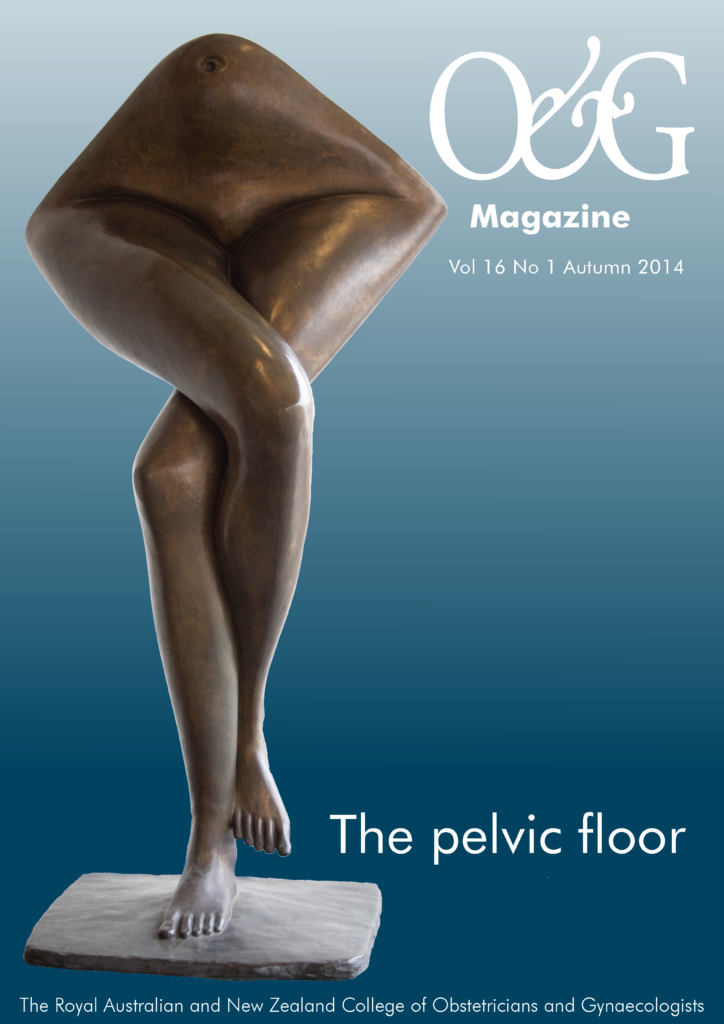Lessons learned from the troubled history of transvaginal mesh kits.
In this article we will discuss the events befalling transvaginal mesh (TVM) over the last four years, where we are now and the necessary considerations when using of TVM for the prevention and treatment of recurrent pelvic organ prolapse.
The decline in the use and availability of TVM
Since 2010, we have witnessed both a fall in the usage as well as the commercial availability of transvaginal mesh products. Although the volume of TVM procedures is not publicly available, US industry sources quoted by the Federal Drug Administration (FDA) would suggest an almost 60 per cent fall in the use of TVM, which now comprises only ten per cent of pelvic floor reconstructive procedures. In Australia such data is not available, however, in the authors’ practice TVM now comprises well below ten per cent of pelvic reconstructive procedures.
Over a similar period, we have seen industry voluntarily withdraw several products. Ethicon has withdrawn all TVM products from the market, while Boston Scientific has withdrawn the PinnacleTM Posterior kit and Bard the AvaultaTM kit. This trend has not been restricted to synthetic mesh products, with Cook announcing they will no longer market their BiodesignTM biological transvaginal graft, citing the prohibitive cost of running FDA mandated ‘522’ post-market surveillance studies. These decisions are without doubt a direct consequence of commercial pressures resulting from regulatory changes, but may also be a consequence of medico-legal challenges. In addition, there is the growing clinical sense that perhaps TVM is not the sole answer to recurrent prolapse prevention and treatment that we all sought.
Medico-legal and financial pressures; innocent victims
The 2011 FDA statement altered the risk classification of TVM to a class III product: a high-risk device. This statement not only clearly stated that the additional complications associated with TVM were ‘not rare’, but also required manufacturers to perform post-market surveillance studies to assess the safety and effectiveness of such products. The cost of a single 522 study is estimated to be millions of dollars and thus far the FDA has ordered no less than 95 post-market studies involving an astonishing 34 manufacturers of TVM.
If this was not enough, the medico-legal industry is in a feeding frenzy, with several law firms offering free case reviews to those who may have had TVM, symptomatic or not, in an attempt to build class actions. There are said to be hundreds of class actions currently in progress, with several commencing in Australia. Two individual lawsuits have so far been reported successful in the USA, with $5.5 million awarded against Bard and a further $11 million against Johnson & Johnson. American Medical Systems recently reported establishing a fund of $54.4 million to settle a number of claims.
Performing a Google search using the term ‘transvaginal mesh’ demonstrates the current profile of TVM: the top-five ranked sites are all associated with law firms. This unbalanced landscape not only affects the psychology of manufacturers and company shareholders, but also the general public’s perception of TVM. The scattergun technique commonly employed by law firms to gather potential plaintiffs also catches other mesh products in its indiscriminating net. Type 1 polypropylene products used in mid-urethral slings and abdominal apical support procedures have now been drawn into the spotlight of adverse publicity, despite their FDA risk classification remaining unchanged as a class II (low to medium risk), as well as being products with strong level 1 evidence supporting their efficacy.
Unsurprisingly, patient advocacy groups have been vocal in their condemnation of mesh products. This has become a deeply emotional and personal issue for some, which is understandable given the reported morbidity caused in particular cases.
TVM has become the rope in the tug-of-war between the remaining mesh-kit producers and the medico-legal industry. Whether TVM kits will remain commercially available seems to be moving slowly, but inexorably, beyond the reach of any evidence-based clinical rationale.
The TVM evidence loses weight in more ways than one
The theoretical rationale for TVM has changed little since 2010. However, the size of the overall high-quality evidence base has actually shrunk considerably, owing to the fact that many of the papers published in the literature now relate to kits that are no longer manufactured. Haya & Maher recently re-analysed the Surgical Management of Pelvic Organ Prolapse Cochrane Meta-analysis1 data to include only currently available kits.2 This resulted in only five RCTs being eligible for re-analysis:
- Nguyen et al, 2008 – PerigeeTM transobturator mesh system (AMS);
- Sivaslioglu et al, 2008 – self-fashioned lightweight PP mesh;
- Nieminen et al, 2010 – self-fashioned lightweight PP mesh;
- Thijs et al, 2010 – Perigee transobturator mesh system (AMS); and
- Menefee et al, 2011 – free-fashioned PP mesh.
These studies recruited a sum total of 242 women and reported results on only one commercial mesh kit: Perigee. In this re-analysis the anterior anatomical recurrence rates (Stage <2 POP-Q), were similar to the original meta-analysis, with 42.8 per cent versus 13.1 per cent (RR 3.3 CI 2.2-4.1) seen in the suture colporrhaphy versus anterior mesh groups, respectively. However, there were neither differences in reoperation rates for anterior prolapse nor patient quality of life. In other words, although there appeared to be an anatomical ‘failure’, no one was seeking further surgery for it. In addition, the mesh groups had greater blood loss (+74ml, C.I. 54-98) and longer operating times (+15mins, C.I. 7-22). We would not be so concerned about these results if it were not for the complications associated with mesh usage, namely symptomatic mesh exposure, chronic pain and dyspareunia. Ten per cent of the mesh group underwent specific surgical intervention for mesh exposure that was seen in 14 per cent of patients. Recently, Crosby et al reported that while 95 per cent of mesh exposures were successfully treated, only 51 per cent of pelvic pain apparently associated with mesh was successfully treated surgically.3
If we look at the evidence for the two low-weight anchored mesh kits commonly used and still currently available in Australia, ElevateTM (American Medical Systems, Minnetonka, USA) and UpholdTM (Boston Scientific), there are no published RCT data. Regarding the Elevate kit, two out of the three published observational studies, one retrospective the other prospective, demonstrated a 92 per cent < Stage 2, anatomical success rate when used in the anterior or posterior compartment. However, these two studies were conducted by investigators with a potential financial conflict of interest and did not compare results with native tissue techniques. A third prospective study of anterior, posterior and combined Elevate performed by investigators with no such conflicts of interest demonstrated a much lower success rate (69 per cent) as defined by an absence of POP-Q ≥Stage 2 . Two-thirds of anatomical recurrences were in the treated compartment however no patient had repeat surgery by 12 months. The mesh exposure rate was 4.5 per cent.4 In the case of the Uphold device, there are actually no published studies independent of those authors who have a clear financial conflict of interest.
Another important fact when considering Elevate and Uphold mesh kits is that these kits are designed to provide level 1 apical as well as level 2 support. As a consequence, they are not necessarily comparable with the previous generations of TVM. We still await the results of the mandated 522 studies, to assess the benefit of these meshes compared with native tissues using outcome measure recommended by IUGA/ICS but these are likely to be several years away. By then, the party may be over.
Should we continue to use transvaginal mesh?
There are women who by virtue of poor connective tissue or its exposure to intolerable stressors may benefit from a graft augmentation. However, the ‘but’ comes in with the issue of selection and engaging in a comprehensive discussion of the options, so arriving at the right operation for the right patient, performed by the right surgeon.
To support the decision-making process there are key resources that can assist clinicians and patients. The two most useful resources are:
- Polypropylene Vaginal Mesh Implants for Vaginal Prolapse (C-Gyn 20) RANZCOG guideline outlining the key issues of informed consent, patient selection and the role of surgical training and experience.5
- The American Urogynecologic Society ‘Informed Consent Toolkit’ for patients and clinicians regarding the use of mesh in the surgical treatment of prolapse.6
Management of surgical innovation and new products
We do not have the answer for all women with pelvic organ prolapse (POP), so there will always be a role for new surgical techniques. However, we need to recognise the lessons offered by the mesh revolution of the last decade:
- Unchecked commercial interest and clinician zeal accelerates the adoption of medical products at a faster rate than the naturally conservative evolution of medical practice would normally allow. This increases the risk of exposing patients to unknown harms that may exceed any perceived benefits.
- Before adopting a new product or technique, ensure level-1 evidence is available for its overall benefit. Failing this, use of such products should only be under the auspices of a well-designed study with long-term monitoring of important outcomes. This recommendation should not be optional and national regulatory bodies need to more critical and vigilant in this regard.
When considering the use of a new POP product, assess the quality of the supportive evidence as suggested by the ICS/IUGA terminology on the reporting of POP surgery trials:
- How was treatment success defined and were all important outcome measures reported?
– Anatomical – POP-Q and what stage?
– Subjective – Patient-reported outcomes (bulge, lower urinary tract, bowel and sexual function), patient satisfaction and quality of life measures.
– Duration of follow-up: early (one year), intermediate (more than three years), late (five years).
– Complication rates and peri-operative outcomes.
– Repeat surgery – same compartment, different compartment and complication related or unrelated?
– Did blinded, independent reviewers without a conflict of interest assess the outcomes? - Also consider whether your patient would meet the inclusion criteria for the study.
- No two mesh kits are the same. Training for each kit is vital to understand patient selection, surgical technique and the additional risks.
By applying this approach, we can ensure that TVM remains an option for those at highest risk of POP recurrence who stand to benefit most, perhaps justifying the additional risks associated with synthetic grafts.
If we look back critically and honestly at the introduction of TVM, we can perhaps admit to ourselves that we were too easily persuaded about mesh benefit when the evidence was clearly incomplete and sadly remains so to this day. When the next innovation emerges we can at least ensure we and our patients are better prepared to meet and benefit from it.
References
- Maher C, Feiner B, Baessler K, Schmid C. Surgical management of pelvic organ Prolapse in women (Review). Cochrane Database of Systematic Reviews. 2013;4 Art. No.: CD004014.
- Haya N, Maher C. Polypropylene Mesh for Pelvic Organ Prolapse Surgery. Current Obstetrics and Gynecology Reports. 2013 Jun 28;2(3):129-38.
- Crosby EC, Abernethy M, Berger MB, DeLancey JO, Fenner DE, Morgan DM. Symptom Resolution After Operative Management of Complications From Transvaginal Mesh. Obstetrics & Gynecology. 2013 Dec;1.
- Azaïs H, Charles CJ, Delporte P, Debodinance P. Prolapse repair using the ElevateTM kit: prospective study on 70 patients. International Urogynecology Journal. 2012 Mar 1;23(10):1421-8.
- Polypropylene Vaginal Mesh Implants for Vaginal Prolapse: RANZCOG [Internet]. 2013 Mar [cited 2014 Jan];College Statement C-Gyn 20. Available from: www.ranzcog.edu.au/doc/polypropylene-vaginal-mesh-implants-for-vaginal-prolapse.html .
- Transvaginal Mesh Informed Consent Toolkit [Internet]. American Urogynecologic Society. [cited 2014 Jan]. Available from: www.augs.org/p/cm/ld/fid=174 .







Leave a Reply